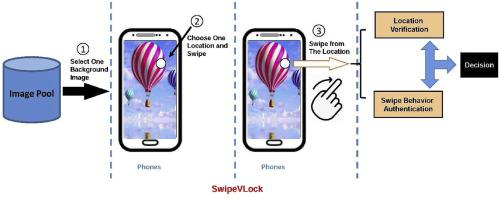Journal of Network and Computer Applications ( IF 7.7 ) Pub Date : 2020-05-11 , DOI: 10.1016/j.jnca.2020.102687 Wenjuan Li , Jiao Tan , Weizhi Meng , Yu Wang

|
With the rapid development of mobile devices, smartphones have become common in people's daily lives, i.e., retrieving community happenings and connecting with peers. Due to the convenience, users often store a large amount of private information on their phones (e.g., photos) and use the phone to process sensitive operations (e.g., financial transactions). Thus, there is a great need to protect the devices from unauthorized access in order to avoid privacy leakage and financial loss. Passwords are the most widely used authentication method, but attackers can take over the phone after it is unlocked. Instead, behavioral authentication can verify current users in a continuous way, which can complement the existing authentication mechanisms like passwords. With the increasing capability of smartphone sensors, users can perform various touch actions to interact with their devices. Motivated by this, in this work, we focus on swipe behavior and develop SwipeVlock, a supervised unlocking mechanism on smartphones, which can authenticate users based on their way of swiping the phone screen with a background image. In the evaluation, we measure several typical supervised learning algorithms and conduct two user studies with over 150 participants. As compared with similar schemes, it is found that participants could perform well with SwipeVLock, i.e., with a success rate of 98% during login and retention.
中文翻译:

基于刷卡的解锁机制,在智能手机上进行监督学习:设计和评估
随着移动设备的迅猛发展,智能手机已成为人们日常生活中的常见事物,即检索社区事件并与同龄人建立联系。由于便利,用户经常在其电话上存储大量私人信息(例如照片),并使用电话来处理敏感操作(例如金融交易)。因此,非常需要保护设备免于未经授权的访问,以避免隐私泄漏和经济损失。密码是使用最广泛的身份验证方法,但是攻击者可以在解锁后接管电话。相反,行为身份验证可以连续方式验证当前用户,这可以补充现有的身份验证机制(例如密码)。随着智能手机传感器功能的增强,用户可以执行各种触摸操作以与其设备进行交互。因此,在这项工作中,我们着重于滑动行为,并开发了SwipeVlock,这是智能手机上的一种受监督的解锁机制,可以根据用户使用背景图像滑动电话屏幕的方式来对用户进行身份验证。在评估中,我们测量了几种典型的监督学习算法,并与150多名参与者进行了两次用户研究。与类似方案相比,发现参与者可以使用SwipeVLock表现良好,即在登录和保留期间的成功率为98%。可以根据用户使用背景图片在手机屏幕上滑动的方式对用户进行身份验证。在评估中,我们测量了几种典型的监督学习算法,并与150多名参与者进行了两次用户研究。与类似方案相比,发现参与者可以使用SwipeVLock表现良好,即在登录和保留期间的成功率为98%。可以根据用户使用背景图片在手机屏幕上滑动的方式对用户进行身份验证。在评估中,我们测量了几种典型的监督学习算法,并与150多名参与者进行了两次用户研究。与类似方案相比,发现参与者可以使用SwipeVLock表现良好,即在登录和保留期间的成功率为98%。







































 京公网安备 11010802027423号
京公网安备 11010802027423号